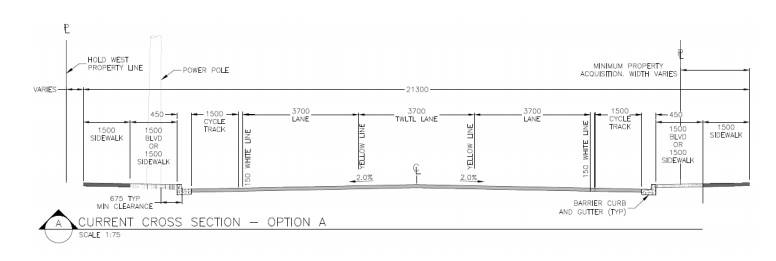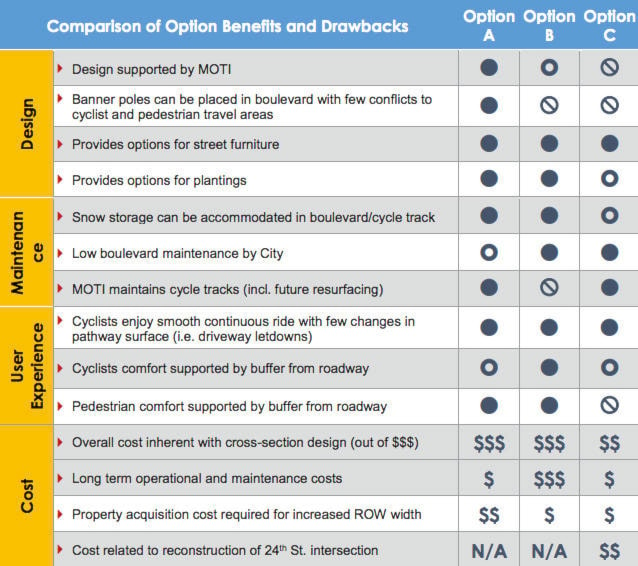Castlegar city council has approved a design for the next phase of the Columbia Avenue redevelopment project.
Using the approved cross-section design is contingent on receiving a federal grant from the Canada Infrastructure Program that would cover 90 per cent of the costs.
Phase 2 will cover the area from 20th Street to 24th Street due to the Ministry of Transportation and Infrastructure’s plans to pave that portion of Columbia Avenue in the summer of 2020. Proceeding with upgrades at the same time would save the city a considerable amount of money, as the ministry will be paying for the paving portion and some of the stormwater works.
Several cross-section options were presented to council at their meeting on June 10.
All options include three traffic lanes.
• Option A includes a 1.5 metre sidewalk and 1.5 metre landscaped boulevard on both sides of the road, followed by curb and gutter and a one-way cycle track on both sides of the road. Travel lanes are separated from the cycle track lanes by a painted white line. Banner poles could be located in the east boulevard. The utility poles on the west side of the road would be relocated into the west boulevard. Landscaping and street furniture could be located in the boulevards on either side.
• Option B is similar to the design of Phase 1, but without options for tree or banner poles due to the utility poles on the west side of the road. It includes a roll-over curb for the cycle track, utility poles relocated to west sidewalk, landscaping and furniture in the sidewalk. Adding landscaping such as trees or banner poles would require obtaining more land and increase the cost significantly.
The ministry did not like Option B and discouraged the city from using it. The reason the ministry gave was that the roll-over curbs and bike lanes will require a lot of handwork and extra paving, causing a concern that the schedule would have to be extended, making it difficult for the ministry to complete their paving on time.
The city estimates the roll-over bike lanes would add an additional four to six weeks of work to the contract.
“Staff and our consultants at the ministry think there is very substantial risk in making sure we keep to schedule throughout the summer,” said Lucas Pitts, the city’s director of civic works.
He explained if the city got behind schedule and caused the ministry to be in breach of contract with their paver, the city would then be responsible for those costs.
Option C is a scaled-down version, but the ministry would not approve the plan due to the need to shift the centre line at the 24th Street intersection in order to accommodate the design.
Options A and B are similar in cost at $3.7 million and $3.68 million.
Total project costs including the ministry’s share are estimated at $6.7 million.
City staff recommended Option A and most of council agreed.
Mayor Bruno Tassone and councillor Cherryl MacLeod preferred Option B.
Tassone thought Option B was a safer option for cycling and stated he thought the boulevards — the areas where trees, baskets and banners would be placed — were a waste of money.
CAO Chris Barlow explained that he felt the bike lanes in Option A were sufficiently safe, due to the fact that they are 1.5 metres wide, compared to the existing 0.9 metre lanes throughout the rest of Columbia Avenue.
Pitts also reminded council that the cycling master plan is designed to steer cyclists off that portion of Columbia Avenue due to the high traffic volume and the number of commercial driveways in that section. He said that adding the raised, roll-over curb bike lanes similar to Phase 1 would go against that purpose and encourage more cycling in that section.
“The initial consultation with the ministry was to continue with the Phase 1 cross section. But every single engineer at the table agreed it was unsafe, because we don’t want to encourage people riding through,” said Pitts.
In the end, all of council except MacLeod and Tassone voted for Option A in the committee of the whole portion of the meeting. However, in the regular council meeting, everyone voted in favour of moving forward with Option A.

